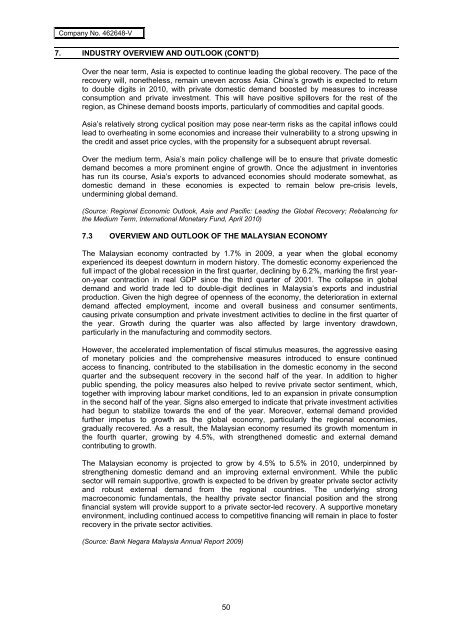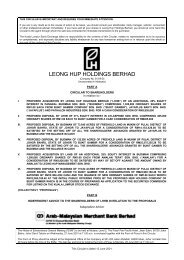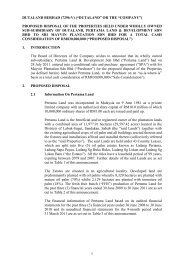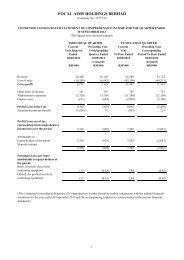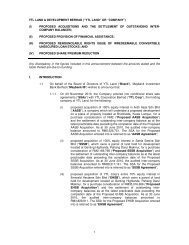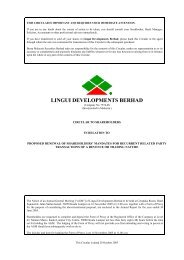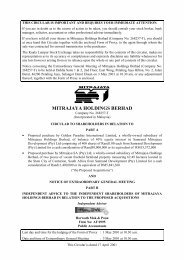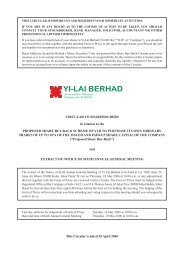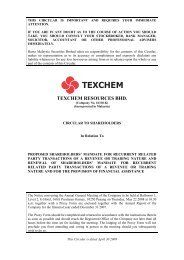SCB Prospectus - Announcements - Bursa Malaysia
SCB Prospectus - Announcements - Bursa Malaysia
SCB Prospectus - Announcements - Bursa Malaysia
You also want an ePaper? Increase the reach of your titles
YUMPU automatically turns print PDFs into web optimized ePapers that Google loves.
Company No. 462648-V<br />
7. INDUSTRY OVERVIEW AND OUTLOOK (CONT’D)<br />
Over the near term, Asia is expected to continue leading the global recovery. The pace of the<br />
recovery will, nonetheless, remain uneven across Asia. China’s growth is expected to return<br />
to double digits in 2010, with private domestic demand boosted by measures to increase<br />
consumption and private investment. This will have positive spillovers for the rest of the<br />
region, as Chinese demand boosts imports, particularly of commodities and capital goods.<br />
Asia’s relatively strong cyclical position may pose near-term risks as the capital inflows could<br />
lead to overheating in some economies and increase their vulnerability to a strong upswing in<br />
the credit and asset price cycles, with the propensity for a subsequent abrupt reversal.<br />
Over the medium term, Asia’s main policy challenge will be to ensure that private domestic<br />
demand becomes a more prominent engine of growth. Once the adjustment in inventories<br />
has run its course, Asia’s exports to advanced economies should moderate somewhat, as<br />
domestic demand in these economies is expected to remain below pre-crisis levels,<br />
undermining global demand.<br />
(Source: Regional Economic Outlook, Asia and Pacific: Leading the Global Recovery; Rebalancing for<br />
the Medium Term, International Monetary Fund, April 2010)<br />
7.3 OVERVIEW AND OUTLOOK OF THE MALAYSIAN ECONOMY<br />
The <strong>Malaysia</strong>n economy contracted by 1.7% in 2009, a year when the global economy<br />
experienced its deepest downturn in modern history. The domestic economy experienced the<br />
full impact of the global recession in the first quarter, declining by 6.2%, marking the first yearon-year<br />
contraction in real GDP since the third quarter of 2001. The collapse in global<br />
demand and world trade led to double-digit declines in <strong>Malaysia</strong>’s exports and industrial<br />
production. Given the high degree of openness of the economy, the deterioration in external<br />
demand affected employment, income and overall business and consumer sentiments,<br />
causing private consumption and private investment activities to decline in the first quarter of<br />
the year. Growth during the quarter was also affected by large inventory drawdown,<br />
particularly in the manufacturing and commodity sectors.<br />
However, the accelerated implementation of fiscal stimulus measures, the aggressive easing<br />
of monetary policies and the comprehensive measures introduced to ensure continued<br />
access to financing, contributed to the stabilisation in the domestic economy in the second<br />
quarter and the subsequent recovery in the second half of the year. In addition to higher<br />
public spending, the policy measures also helped to revive private sector sentiment, which,<br />
together with improving labour market conditions, led to an expansion in private consumption<br />
in the second half of the year. Signs also emerged to indicate that private investment activities<br />
had begun to stabilize towards the end of the year. Moreover, external demand provided<br />
further impetus to growth as the global economy, particularly the regional economies,<br />
gradually recovered. As a result, the <strong>Malaysia</strong>n economy resumed its growth momentum in<br />
the fourth quarter, growing by 4.5%, with strengthened domestic and external demand<br />
contributing to growth.<br />
The <strong>Malaysia</strong>n economy is projected to grow by 4.5% to 5.5% in 2010, underpinned by<br />
strengthening domestic demand and an improving external environment. While the public<br />
sector will remain supportive, growth is expected to be driven by greater private sector activity<br />
and robust external demand from the regional countries. The underlying strong<br />
macroeconomic fundamentals, the healthy private sector financial position and the strong<br />
financial system will provide support to a private sector-led recovery. A supportive monetary<br />
environment, including continued access to competitive financing will remain in place to foster<br />
recovery in the private sector activities.<br />
(Source: Bank Negara <strong>Malaysia</strong> Annual Report 2009)<br />
50


